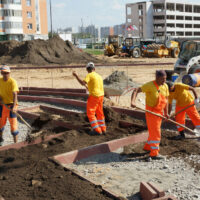
Developments have also included numerous capacity expansions. Amongst others, the number of bathrooms available in the terminals has been increased by 70% to 28, while all existing toilets have been refurbished, new passenger security screening lanes have been added, the curbside and Premium Parking in front of the terminal and the pedestrian walkways leading from the car parks to the terminal have been refurbished and the floor tiles in Terminal 2A have been replaced.
A new escalator has been installed in Pier B and the operator has handed over new elevators on the arrivals level of Terminals 2A and 2B.
The number of brand new self-service baggage drop-off machines available in the terminals is 30, while the number of automatic passport control gates has increased to 12, and thanks to the 13 drinking fountains, passengers can avoid the need to consume plastic bottled water, by refilling their water bottles in the terminal.
The dynamic pace of airport developments continued in 2021 as well, ensuring the continuous improvement and expansion of services and strengthening the airport’s regional advantage, which is a priority for both the owners and management of Budapest Airport. Despite the severe impact of the coronavirus pandemic in 2021, which also had a massive effect on the operator’s revenues, Budapest Airport did not suspended investments. On the contrary, it brought forward certain developments, which were easier to implement during the low passenger traffic period.
Summary of developments in 2021
The new Main Gate of the airport was completed with a budget of 830 million HUF, and officially opened on 15 November 2021. Comprising a 440-square-meter building and 123 parking spaces, the facility has nearly two and a half times the capacity of the previous main gate, allowing faster and smoother access for employees, tenants and partners arriving in the operational area of the airport. The new Main Gate has been designed with Budapest Airport’s net zero carbon targets in mind. There is a 3000-square-meter green area surrounding the building, which has excellent energy efficiency features and solar panels on the roof, providing one-third of the building’s electricity needs. In addition, four electric charging stations are being installed at the Main Gate and another thirty charging stations are being constructed at other locations at the airport, as part of the airport’s e-mobility promotion program.

The airport’s taxiways and service roads have also undergone a number of refurbishments. Five taxiways and their shoulders have been renewed, in several phases, the three-kilometer-long main service road of the airport has been completely resurfaced and modernized with new LED floodlighting, several lighting upgrades have been carried out, and the asphalt on the Terminal 1 apron has been replaced with high-strength and high load-bearing basalt concrete.
A new escalator in Pier B was completed at the end of June. At the same time, the elevators in the terminals were modernized; the lifts connecting the departure and
the arrival levels at Terminals 2A and 2B were renewed.
The modernization of lifts is ongoing continuously at the airport. As a development that is not visible to passengers but facilitates the smooth operation of background processes, the freight elevator used to transport oversized baggage will also be renewed, which will carry passengers’ oversized baggage directly to the baggage sorting hall. Works have started in January, so as not to disrupt normal passenger traffic.
Other refurbishment works to improve the internal atmosphere were also carried out at the terminals last year; on the arrivals level of Terminal 2B, around the passport control booths and in the arrivals hall of Terminal 2A, the airport operator replaced the suspended ceiling, and at the same time, the fluorescent lighting was replaced with modern and energy
efficient LED lighting.
Modernization everywhere
There was also significant modernization in IT during the first half of the year, with four major system upgrades completed, to take advantage of the low passenger numbers. New functions were added to the airport’s critical IT systems, thanks to the replacement of hardware and software tools. The technology change provides greater capacity and better quality systems, both for internal users and business partners. As part of the renewal of the baggage sorting system, security monitoring workstations have been consolidated and the old X-ray machines were removed, eliminating the need for passengers to remove electronic devices from hand baggage, for security screening. The replacement of all industrial fast gates in the baggage sorting halls of the SkyCourt and Terminal 2A is also underway.
Another 3 heating centers were successfully renewed before the heating season, and the operator plans to reconstruct two more heating centers for hangars in the spring.
By upgrading the thermal insulation of more than 2500 fittings that provide heat for office areas, warehouses and hangars, the airport will save 170 000 m3 of natural gas and 340 tons of carbon dioxide emissions per year, significantly reducing the environmental impact of the airport. In addition, the 10 kV protection and control systems of the airport’s transformer stations have also been modernized. The replaced protection devices are designed to ensure the smooth operation of runway navigation aids and airfield ground lighting fixtures on the taxiways. Finally, the airport operator also upgraded its fire alarm systems, which is essential to maintain safe operations and to comply with the National Fire Safety Regulations.
Some major investments and building renovations by partner companies operating at the airport also started or were completed last year. On the airside of the airport, Aeroplex of Central Europe (ACE) commenced the construction of its new 8000-square-meter hangar, while, as a result of the new hangar, Budapest Airport replaced a major section of the main rainwater drainage canal under the technical apron. As part of a joint project between Hungarian Post and Budapest Airport, postal premises at the airport were refurbished, in order to optimize the international mail service and to comply with the changed EU regulations on the handling of mail. In addition, the cooperation between HungaroControl and Budapest Airport, the so-called Remote Tower project, continued. The system, globally one of the first at a medium-sized gateway like Budapest Airport, is essentially a virtual tower that enables air traffic controllers to perform their tasks from a remote control center, off-airport.
Regional gold medal in the passenger satisfaction survey
Thanks to the investments made at Ferenc Liszt International Airport, passenger satisfaction has been steadily increasing over the past three years. In the results of the quarterly ASQ (airport service quality) surveys, the last quarter of 2021 surpassed all previous results. The anonymous survey, which is performed by an independent third party, asks passengers to rate the airport services that affect them most according to 37 different criteria, and the scores recorded in the last quarter of 2021 confirm that the more than 70 billion HUF series of developments implemented over the last three years has paid off, with very strong quality scores.
Overall passenger satisfaction jumped by +15% in the last quarter of 2021,
which is a strong performance when compared to other airports. Ferenc Liszt International Airport achieved a significant leap in quality with these results. The airport operator has managed to improve passenger satisfaction in all 37 categories.
In early February, Budapest Airport also received ACI World’s “The Voice of the Customer” accolade, which is given to airports that made significant efforts to collect passenger feedback during the epidemic, through the ASQ program. Budapest Airport continued to collect and evaluate passenger feedback over the past two years, during the pandemic, whereby it has placed a strong focus on improving the passenger experience and meeting expectations relating to the pandemic. More than 200 airports received this accolade worldwide in 2022.
Commenting on the developments, Chris Dinsdale, the CEO of Budapest Airport highlighted: “We have reason to be proud, having implemented huge developments at the airport worth more than 70 billion HUF over three years, which is confirmed by the positive feedback from passengers. What is more, the series of developments at the airport is far from over. On the contrary, even bigger investments are coming. In 2021, preparatory works for the reopening of Terminal 1 began, and we are already in the permitting phase.
Preparations for the construction of the new Terminal 3 are also underway; the plans are ready, and we are continuously preparing the airport for this major construction project.”
He added: “If everything goes according to plan, Terminal 1 will welcome its first passengers in the summer of 2024, while Terminal 3 is expected to be completed by 2028. In other words, the spectacular development of the airport and the continuous quality improvement will not stop; the gateway to Hungary must remain the best airport in the region.”



